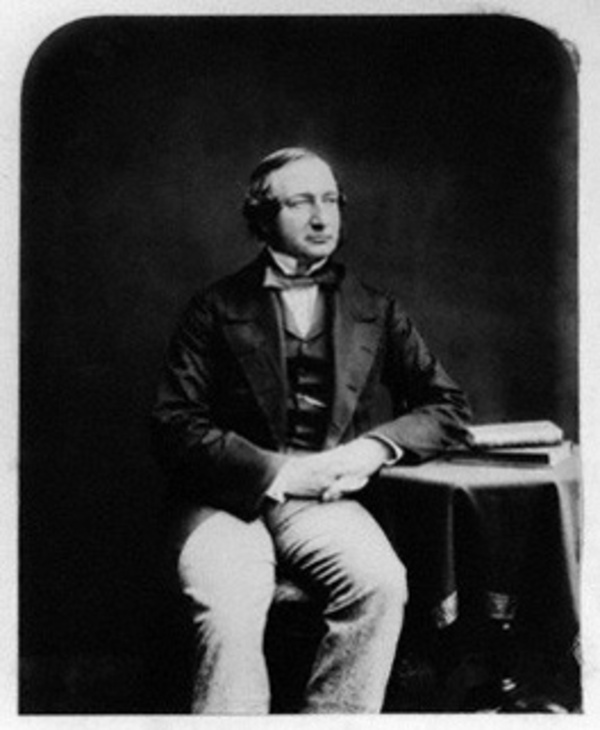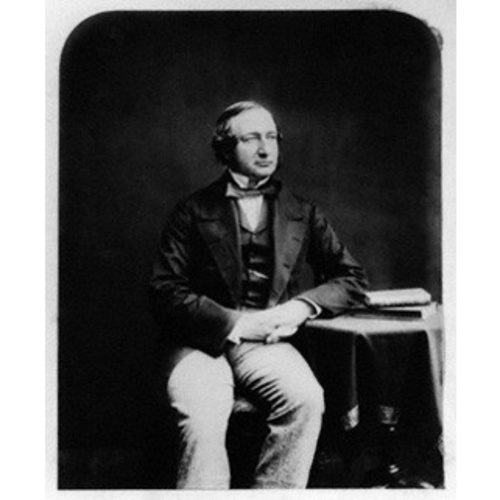
Source: Link
WARBURTON, GEORGE DROUGHT, army officer and writer; b. 2 June 1816 in Wicklow (Republic of Ireland), third son of George Warburton and Anna Acton; m. 30 June 1853 Elizabeth Augusta Bateman-Hanbury, and they had one daughter, who later married Lord Edward Spencer-Churchill; d. 23 Oct. 1857, by his own hand, in Frant (East Sussex), England.
George Drought Warburton was sent to the Royal Military Academy, Woolwich (London), by his father, who had been inspector general of the Irish constabulary. He entered the Royal Artillery as a 2nd lieutenant on 21 June 1833 and was promoted 1st lieutenant on St Patrick’s Day 1836. Serving on the north coast of Spain from February 1837 to October 1838 during the Carlist War, Warburton was wounded on 15 March 1837 near Hernani and received the 1st class of the Order of St Ferdinand. Promoted 2nd captain in the late spring of 1844, he left Woolwich on 17 July for a posting in the Canadas. He was stationed at Montreal from 4 Sept. 1844 to 15 July 1845 and from 19 Dec. 1845 to 1 March 1847, when he was granted six months’ leave on “Private affairs.”
During his stay in Canada, Warburton wrote “an agreeable description of the dominion,” Hochelaga; or, England in the New World, published anonymously in London in 1846. His older brother, Bartholomew Elliott George (usually Eliot), who edited the book, had himself established a reputation as a travel-book author two years earlier with The crescent and the cross; or, romance and realities of eastern travel. Eliot’s friendship with Alexander William Kinglake, author of the travel classic Eothen; or traces of travel brought home from the East, and acquaintanceship with Alexis de Tocqueville suggest a family interest in sophisticated travel writing. Hochelaga reflects George’s experiences in North America. While in Quebec City he witnessed two terrible fires, on 28 May and 28 June 1845. He describes Montreal, Kingston, and Toronto, diligently noting social and political features as well as geographical ones, and the book includes a lively history of the “rebellious movements” of 1837. His later tours included a sweep from Buffalo through Philadelphia to Washington and back via Boston to Montreal; his comparisons between Canada and the United States are perceptive and lively. He watched the progress of canal-building and was convinced of the need for a railway system in Canada to further British interests and to consolidate the colonies. Hochelaga went through several editions in England and the United States, and became staple reading for the next generation of travellers.
On 1 Nov. 1848 Warburton was promoted 1st captain and took command of the 4th Company of the 6th Battalion of Royal Artillery stationed at Corfu (Greece). His company returned to Woolwich in May 1849 and that year he published, again anonymously, his two-volume work The conquest of Canada. From a lively history of the military campaigns of the 18th century, including several vignettes of army figures, he broadens to a general history. He also sketches the geological and agricultural possibilities, even in the “dreary solitudes” north of Lake Superior, and adds a carefully researched account of Canadian Indians. His writing is as lively as that of John Richardson in his history of the War of 1812: indeed, of early histories, only George Heriot*’s The history of Canada is comparable to Warburton’s work in coverage and liveliness. The conquest of Canada enjoyed a second London edition as well as a New York edition in 1850, and was being reprinted as late as 1864.
In September 1850 the company under Warburton’s command was stationed at Landguard Fort, near Harwich, and, during his frequent visits to London, George joined his brother as part of Lady Morgan’s witty circle. A third literary production, A memoir of Charles Mordaunt, “by the author of Hochelaga,” appeared in 1853. During that eventful year, Eliot died in a fire at sea, George married the daughter of Lord Bateman, his company was sent to Guernsey in September, and he retired from the army with full pay on 29 November. He moved to Henley House, Frant, and on 28 Nov. 1854 was promoted major of the Royal Artillery. On 28 March 1857 he was elected to parliament by a large majority as an Independent Liberal for Harwich. On 23 October, “in a fit of temporary insanity” induced by pains of indigestion to which he was subject, he shot himself through the head.
George Warburton’s life was brief and his direct experience of Canada lasted less than two years. Yet his accounts of Canada remain as testimony to an agreeable, spirited personality. The conquest of Canada helped Britons understand Canadian history and aspirations and Hochelaga popularized the notions of Canadian landscape as attractive and Canadian society as engaging and entertaining.
George Drought Warburton is the author of Hochelaga; or, England in the New World, ed. [B.] E. [G.] Warburton (2v., London, 1846); The conquest of Canada (2v., London, 1849); and A memoir of Charles Mordaunt, earl of Peterborough and Monmouth: with selections from his correspondence (2v., London, 1853).
PRO, WO 17/1548–51 (mfm. at PAC). George Heriot, The history of Canada, from its first discovery, comprehending an account of the original establishment of the colony of Louisiana (London, 1804). [John] Richardson, War of 1812 . . . ([Brockville, Ont.], 1842). Battery records of the Royal Artillery, 1716–1859, comp. M. E. S. Laws (Woolwich, Eng., 1952). DNB (biogs. of George Drought Warburton, Bartholomew Elliott George Warburton, Sydney Morgan, Lady Morgan). G.B., WO, Army list, 1834–58. Hart’s army list, 1840–57. Morgan, Bibliotheca Canadensis, 387. K. N. Windsor, “Historical writing in Canada to 1920,” Lit. hist. of Canada (Klinck et al.; 1976), 1: 226, 228.
Cite This Article
Elizabeth Waterston, “WARBURTON, GEORGE DROUGHT,” in Dictionary of Canadian Biography, vol. 8, University of Toronto/Université Laval, 2003–, accessed April 28, 2025, https://www.biographi.ca/en/bio/warburton_george_drought_8E.html.
The citation above shows the format for footnotes and endnotes according to the Chicago manual of style (16th edition). Information to be used in other citation formats:
| Permalink: | https://www.biographi.ca/en/bio/warburton_george_drought_8E.html |
| Author of Article: | Elizabeth Waterston |
| Title of Article: | WARBURTON, GEORGE DROUGHT |
| Publication Name: | Dictionary of Canadian Biography, vol. 8 |
| Publisher: | University of Toronto/Université Laval |
| Year of revision: | 1985 |
| Access Date: | April 28, 2025 |



